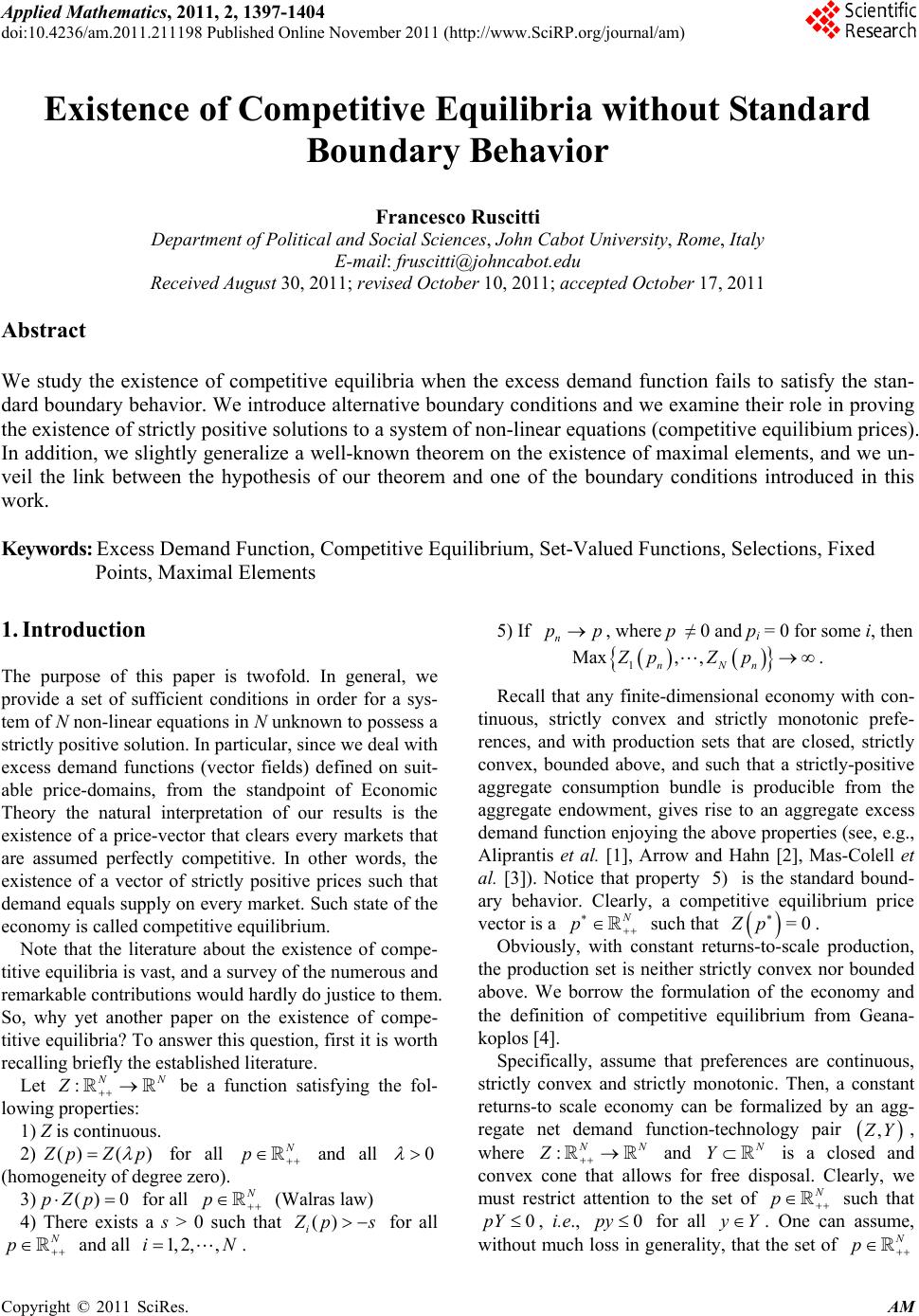 Applied Mathematics, 2011, 2, 1397-1404 doi:10.4236/am.2011.211198 Published Online November 2011 (http://www.SciRP.org/journal/am) Copyright © 2011 SciRes. AM Existence of Competitive Equilibria without Standard Boundary Behavior Francesco Ruscitti Department of Political and Social Sciences, John Cabot University, Rome, Italy E-mail: fruscitti@johncabot.edu Received August 30, 2011; revised October 10, 2011; accepted October 17, 2011 Abstract We study the existence of competitive equilibria when the excess demand function fails to satisfy the stan- dard boundary behavior. We introduce alternative boundary conditions and we examine their role in proving the existence of strictly positive solutions to a system of non-linear equations (competitive equilibium prices). In addition, we slightly generalize a well-known theorem on the existence of maximal elements, and we un- veil the link between the hypothesis of our theorem and one of the boundary conditions introduced in this work. Keywords: Excess Demand Function, Competitive Equilibrium, Set-Valued Functions, Selections, Fixed Points, Maximal Elements 1. Introduction The purpose of this paper is twofold. In general, we provide a set of sufficient conditions in order for a sys- tem of N non-linear equations in N unknown to possess a strictly positive solution. In particular, since we deal with excess demand functions (vector fields) defined on suit- able price-domains, from the standpoint of Economic Theory the natural interpretation of our results is the existence of a price-vector that clears every markets that are assumed perfectly competitive. In other words, the existence of a vector of strictly positive prices such that demand equals supply on every market. Such state of the economy is called competitive equilibrium. Note that the literature about the existence of compe- titive equilibria is vast, and a survey of the numerous and remarkable contributions would hardly do justice to them. So, why yet another paper on the existence of compe- titive equilibria? To answer this question, first it is worth recalling briefly the established literature. Let : N Z be a function satisfying the fol- lowing properties: 1) Z is continuous. 2) ()( ) pZp for all p and all 0 (homogeneity of degree zero). 3) for all () 0pZp p (Walras law) 4) There exists a s > 0 such that () i p 5) If , where p ≠ 0 and pi = 0 for some i, then n pp 1 Max, , nNn ZpZ p. Recall that any finite-dimensional economy with con- tinuous, strictly convex and strictly monotonic prefe- rences, and with production sets that are closed, strictly convex, bounded above, and such that a strictly-positive aggregate consumption bundle is producible from the aggregate endowment, gives rise to an aggregate excess demand function enjoying the above properties (see, e.g., Aliprantis et al. [1], Arrow and Hahn [2], Mas-Colell et al. [3]). Notice that property is the standard bound- ary behavior. Clearly, a competitive equilibrium price vector is a 5) p such that . =0Zp Obviously, with constant returns-to-scale production, the production set is neither strictly convex nor bounded above. We borrow the formulation of the economy and the definition of competitive equilibrium from Geana- koplos [4]. Specifically, assume that preferences are continuous, strictly convex and strictly monotonic. Then, a constant returns-to scale economy can be formalized by an agg- regate net demand function-technology pair , Y, where : N Z and is a closed and convex cone that allows for free disposal. Clearly, we must restrict attention to the set of N Y p such that 0pY , i.e., 0py for all Y. One can assume, without much loss in generality, that the set of p s for all p and all . 1, 2,,iN 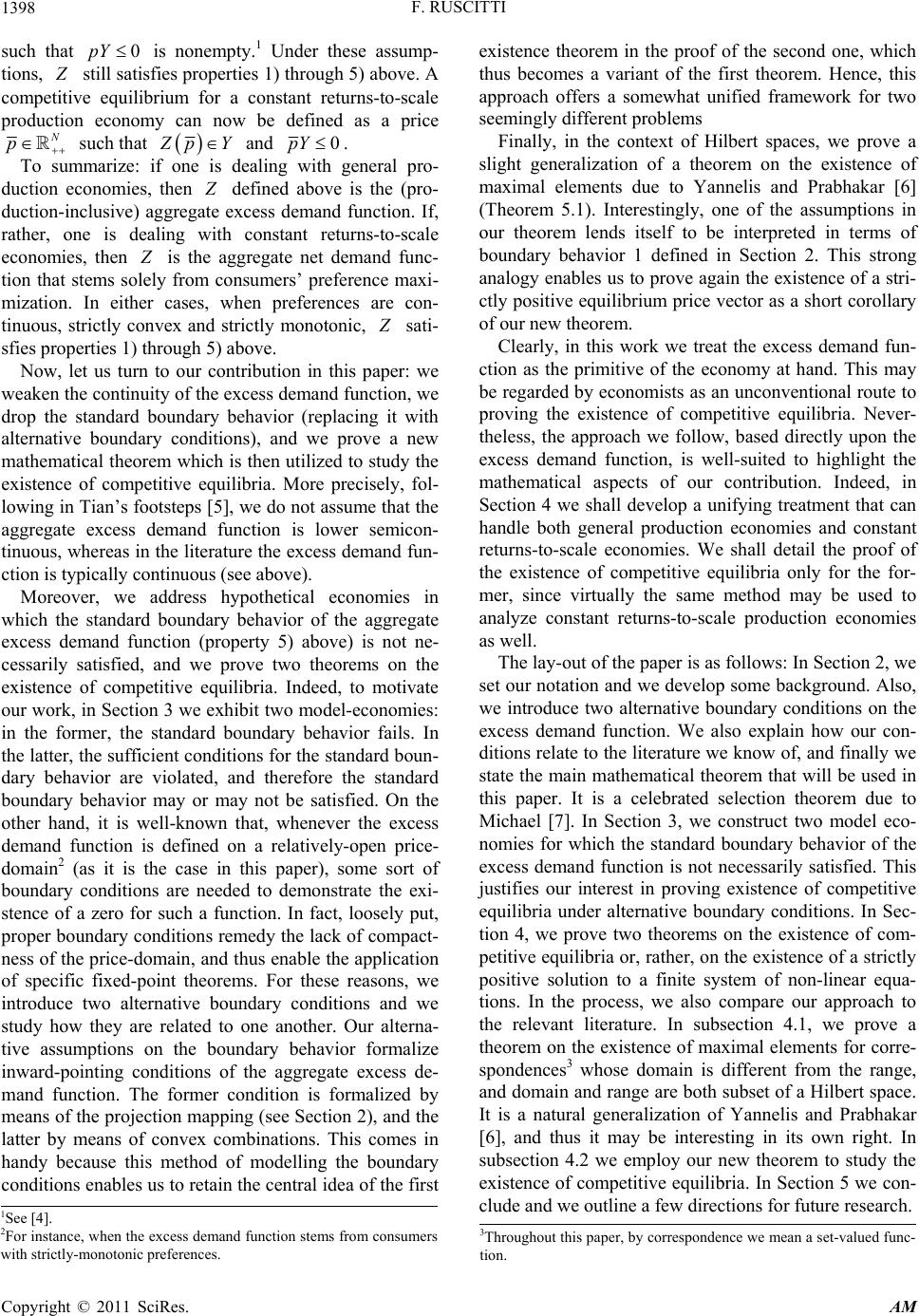 F. RUSCITTI 1398 such that is nonempty.1 Under these assump- tions, 0pY still satisfies properties 1) through 5) above. A competitive equilibrium for a constant returns-to-scale production economy can now be defined as a price p such that pY and 0pY. To summarize: if one is dealing with general pro- duction economies, then defined above is the (pro- duction-inclusive) aggregate excess demand function. If, rather, one is dealing with constant returns-to-scale economies, then is the aggregate net demand func- tion that stems solely from consumers’ preference maxi- mization. In either cases, when preferences are con- tinuous, strictly convex and strictly monotonic, sati- sfies properties 1) through 5) above. Now, let us turn to our contribution in this paper: we weaken the continuity of the excess demand function, we drop the standard boundary behavior (replacing it with alternative boundary conditions), and we prove a new mathematical theorem which is then utilized to study the existence of competitive equilibria. More precisely, fol- lowing in Tian’s footsteps [5], we do not assume that the aggregate excess demand function is lower semicon- tinuous, whereas in the literature the excess demand fun- ction is typically continuous (see above). Moreover, we address hypothetical economies in which the standard boundary behavior of the aggregate excess demand function (property 5) above) is not ne- cessarily satisfied, and we prove two theorems on the existence of competitive equilibria. Indeed, to motivate our work, in Section 3 we exhibit two model-economies: in the former, the standard boundary behavior fails. In the latter, the sufficient conditions for the standard boun- dary behavior are violated, and therefore the standard boundary behavior may or may not be satisfied. On the other hand, it is well-known that, whenever the excess demand function is defined on a relatively-open price- domain2 (as it is the case in this paper), some sort of boundary conditions are needed to demonstrate the exi- stence of a zero for such a function. In fact, loosely put, proper boundary conditions remedy the lack of compact- ness of the price-domain, and thus enable the application of specific fixed-point theorems. For these reasons, we introduce two alternative boundary conditions and we study how they are related to one another. Our alterna- tive assumptions on the boundary behavior formalize inward-pointing conditions of the aggregate excess de- mand function. The former condition is formalized by means of the projection mapping (see Section 2), and the latter by means of convex combinations. This comes in handy because this method of modelling the boundary conditions enables us to retain the central idea of the first existence theorem in the proof of the second one, which thus becomes a variant of the first theorem. Hence, this approach offers a somewhat unified framework for two seemingly different problems Finally, in the context of Hilbert spaces, we prove a slight generalization of a theorem on the existence of maximal elements due to Yannelis and Prabhakar [6] (Theorem 5.1). Interestingly, one of the assumptions in our theorem lends itself to be interpreted in terms of boundary behavior 1 defined in Section 2. This strong analogy enables us to prove again the existence of a stri- ctly positive equilibrium price vector as a short corollary of our new theorem. Clearly, in this work we treat the excess demand fun- ction as the primitive of the economy at hand. This may be regarded by economists as an unconventional route to proving the existence of competitive equilibria. Never- theless, the approach we follow, based directly upon the excess demand function, is well-suited to highlight the mathematical aspects of our contribution. Indeed, in Section 4 we shall develop a unifying treatment that can handle both general production economies and constant returns-to-scale economies. We shall detail the proof of the existence of competitive equilibria only for the for- mer, since virtually the same method may be used to analyze constant returns-to-scale production economies as well. The lay-out of the paper is as follows: In Section 2, we set our notation and we develop some background. Also, we introduce two alternative boundary conditions on the excess demand function. We also explain how our con- ditions relate to the literature we know of, and finally we state the main mathematical theorem that will be used in this paper. It is a celebrated selection theorem due to Michael [7]. In Section 3, we construct two model eco- nomies for which the standard boundary behavior of the excess demand function is not necessarily satisfied. This justifies our interest in proving existence of competitive equilibria under alternative boundary conditions. In Sec- tion 4, we prove two theorems on the existence of com- petitive equilibria or, rather, on the existence of a strictly positive solution to a finite system of non-linear equa- tions. In the process, we also compare our approach to the relevant literature. In subsection 4.1, we prove a theorem on the existence of maximal elements for corre- spondences3 whose domain is different from the range, and domain and range are both subset of a Hilbert space. It is a natural generalization of Yannelis and Prabhakar [6], and thus it may be interesting in its own right. In subsection 4.2 we employ our new theorem to study the existence of competitive equilibria. In Section 5 we con- clude and we outline a few directions for future research. 1See [4]. 2For instance, when the excess demand function stems from consumers with strictly-monotonic preferences. 3Throughout this paper, by correspondence we mean a set-valued func- tion. Copyright © 2011 SciRes. AM 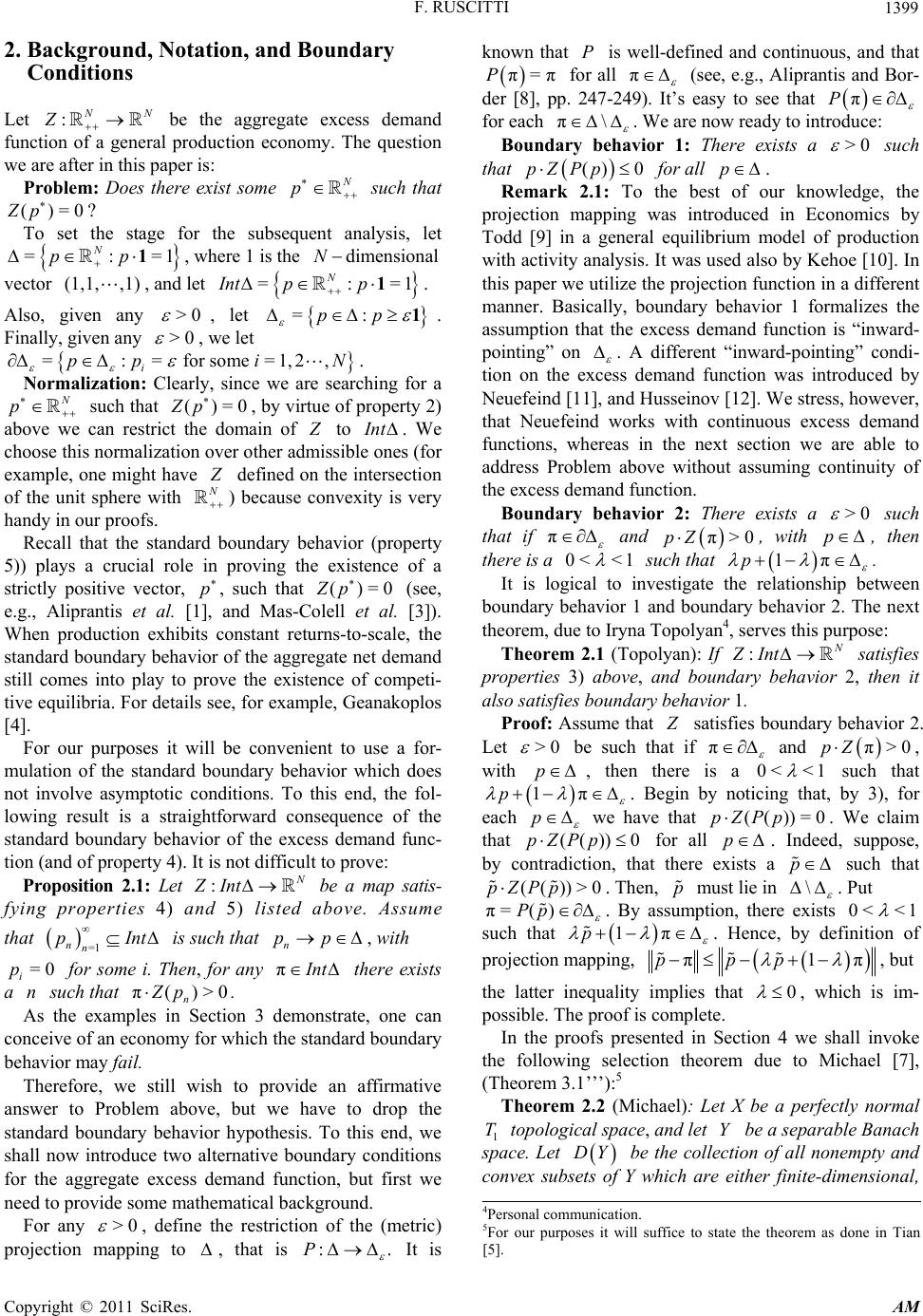 F. RUSCITTI1399 2. Background, Notation, and Boundary Conditions Let : N Z be the aggregate excess demand function of a general production economy. The question we are after in this paper is: Problem: Does there exist some p such that ? ()=0Zp To set the stage for the subsequent analysis, let , where 1 is the dimensional =: N pp 1 (1,1, ,1) =1 =1 N N vector , and let . =:Int pp 1 Also, given any >0 , let =:pp 1. Finally, given any >0 , we let . = for =:some pp = 1, 2,i N i Normalization: Clearly, since we are searching for a p such that , by virtue of property 2) above we can restrict the domain of ()=0Zp to nt . We choose this normalization over other admissible ones (for example, one might have defined on the intersection of the unit sphere with ) because convexity is very handy in our proofs. Recall that the standard boundary behavior (property 5)) plays a crucial role in proving the existence of a strictly positive vector, , such that (see, e.g., Aliprantis et al. [1], and Mas-Colell et al. [3]). When production exhibits constant returns-to-scale, the standard boundary behavior of the aggregate net demand still comes into play to prove the existence of competi- tive equilibria. For details see, for example, Geanakoplos [4]. p()=0Zp For our purposes it will be convenient to use a for- mulation of the standard boundary behavior which does not involve asymptotic conditions. To this end, the fol- lowing result is a straightforward consequence of the standard boundary behavior of the excess demand func- tion (and of property 4). It is not difficult to prove: Proposition 2.1: Let : ZInt be a map satis- fying properties 4) and 5) listed above. Assume that is such that , with =1 nn pIn tn pp =0 i p for some i. Then, for any π nt there exists a such that . nπ()>0 n Zp As the examples in Section 3 demonstrate, one can conceive of an economy for which the standard boundary behavior may fail. Therefore, we still wish to provide an affirmative answer to Problem above, but we have to drop the standard boundary behavior hypothesis. To this end, we shall now introduce two alternative boundary conditions for the aggregate excess demand function, but first we need to provide some mathematical background. For any >0 , define the restriction of the (metric) projection mapping to , that is :P. It is known that is well-defined and continuous, and that P π=πP for all π (see, e.g., Aliprantis and Bor- der [8], pp. 247-249). It’s easy to see that πP for each π\ . We are now ready to introduce: Boundary behavior 1: There exists a >0 such that ()Pp 0pZ for all . p Remark 2.1: To the best of our knowledge, the projection mapping was introduced in Economics by Todd [9] in a general equilibrium model of production with activity analysis. It was used also by Kehoe [10]. In this paper we utilize the projection function in a different manner. Basically, boundary behavior 1 formalizes the assumption that the excess demand function is “inward- pointing” on . A different “inward-pointing” condi- tion on the excess demand function was introduced by Neuefeind [11], and Husseinov [12]. We stress, however, that Neuefeind works with continuous excess demand functions, whereas in the next section we are able to address Problem above without assuming continuity of the excess demand function. Boundary behavior 2: There exists a >0 such that if π and , with π>0pZp , then there is a 0< <1 such that 1πp . It is logical to investigate the relationship between boundary behavior 1 and boundary behavior 2. The next theorem, due to Iryna Topolyan4, serves this purpose: Theorem 2.1 (Topolyan): If : ZInt satisfies properties 3) above, and boundary behavior 2, then it also satisfies boundary behavior 1. Proof: Assume that satisfies boundary behavior 2. Let >0 be such that if π and π>0pZ, with p , then there is a 0< <1 such that π1p . Begin by noticing that, by 3), for each p )) we have that . We claim that ((pZP))p=0 (( Pp 0pZ for all . Indeed, suppose, by contradiction, that there exists a such that p p ((pZPp))>0 . Then, must lie in p \ . Put π=()Pp . By assumption, there exists 0<<1 such that π1p . Hence, by definition of projection mapping, π1ppp π , but the latter inequality implies that 0 , which is im- possible. The proof is complete. In the proofs presented in Section 4 we shall invoke the following selection theorem due to Michael [7], (Theorem 3.1’’’):5 Theorem 2.2 (Michael): Let X be a perfectly normal 1pological space, and let Y be a separable Banach space. Let T to DY be the collection of all nonempty and convex subsets of Y which are either finite-dimensional, 4Personal communication. 5For our purposes it will suffice to state the theorem as done in Tian [5]. Copyright © 2011 SciRes. AM 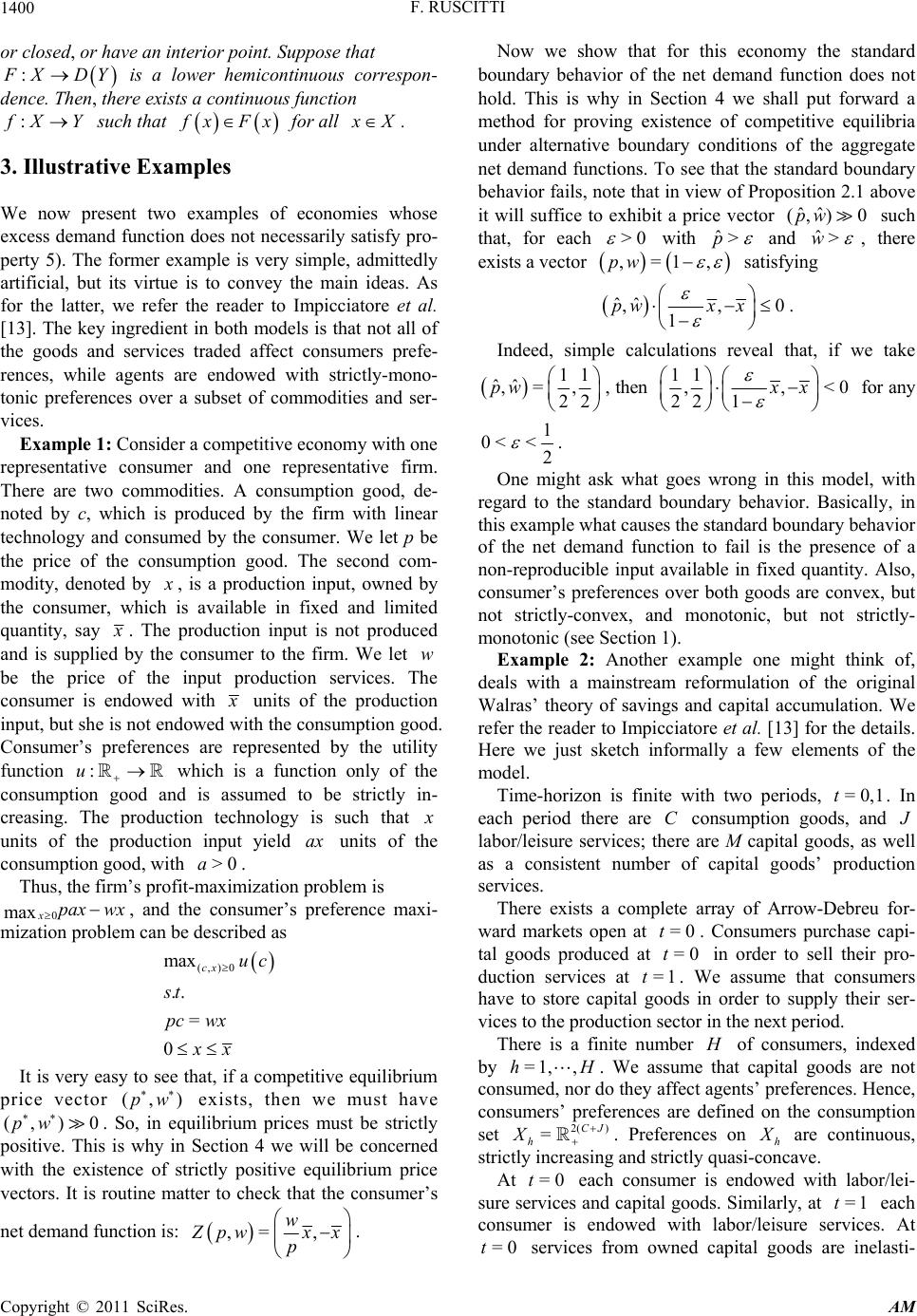 F. RUSCITTI 1400 or closed, or have an interior point. Suppose that : XDY dence. Then, th is a lower hemicontinuous correspon- ere exists a continuous function : XY such that xFx for all X . . Illustrative Examples e now present two examples of economies whose ple 1: Consider a competitive economy with one re 3 W excess demand function does not necessarily satisfy pro- perty 5). The former example is very simple, admittedly artificial, but its virtue is to convey the main ideas. As for the latter, we refer the reader to Impicciatore et al. [13]. The key ingredient in both models is that not all of the goods and services traded affect consumers prefe- rences, while agents are endowed with strictly-mono- tonic preferences over a subset of commodities and ser- vices. Exam presentative consumer and one representative firm. There are two commodities. A consumption good, de- noted by c, which is produced by the firm with linear technology and consumed by the consumer. We let p be the price of the consumption good. The second com- modity, denoted by , is a production input, owned by the consumer, which is available in fixed and limited quantity, say . The production input is not produced and is supplied by the consumer to the firm. We let w be the price of the input production services. T consumer is endowed with he units of the production input, but she is not endowed ith the consumption good. Consumer’s preferences are represented by the utility function :u which is a function only of the consumptnd is assumed to be strictly in- creasing. The production technology is such that w ion good a units of the production input yield ax units of th consumption good, with >0a. Thus, the firm’s profit-ization p e maximroblem is axi- 0 ax xpax wx , and the consumer’s preference m can be described as m mization problem (, )0 max cx uc .. = 0 st pc wx xx It is very easy to see that, if a competitive equilibrium pr ice vector (, )pw exists, then we must have (, )0pw . So, in equilibrium prices must be strictly is why in Section 4 we will be concerned with the existence of strictly positive equilibrium price vectors. It is routine matter to check that the consumer’s net demand function is: positive. This ,=, w pwx x . p for this economy the standard e net demand function does not ho Now we show that boundary behavior of th ld. This is why in Section 4 we shall put forward a method for proving existence of competitive equilibria under alternative boundary conditions of the aggregate net demand functions. To see that the standard boundary behavior fails, note that in view of Proposition 2.1 above it will suffice to exhibit a price vector ˆˆ (, )0pw such that, for each >0 with ˆ>p and ˆ>w , there exists a vector ,=1,pw satisfying ˆˆ ,,0x x 1 pw Indeed, simple calculations reveal that, if we take . 11 ˆˆ ,=, 22 pw , then 11 ,,<0xx for any 22 1 1 0< <2 . One might ask what goes wrong in this model, with regard to the standard boundary behavior. Basically, in this example what causes the standard boundary behavior of the net demand function to fail is the presence of a non-reproducible input available in fixed quantity. Also, consumer’s preferences over both goods are convex, but not strictly-convex, and monotonic, but not strictly- monotonic (see Section 1). Example 2: Another example one might think of, deals with a mainstream reformulation of the original Walras’ theory of savings and capital accumulation. We refer the reader to Impicciatore et al. [13] for the details. Here we just sketch informally a few elements of the model. Time-horizon is finite with two periods, =0,1t. In each period there are C consumption goods, and labor/leisure services; there are M capital goods, as as a consistent number of capital goods’ production services. There exists a complete array of Arrow-Debreu for- ward markets open at =0t. Consumers purchase capi- tal well ods i ec goods produced at =0t in order to sell their pro- duction services at =1t. We assume that consumers have to store capital gon order to supply their ser- vices to the production stor in the next period. There is a finite number of consumers, indexed by =1, ,hH. We assume that capital goods are not consumed, nor do they affect agents’ preferences. Hence, consumers’ preferences are defined on the consumption set ) =J h X . Preferences on h 2( C are continuous, strictly increasing and strictly quasi-concave. At =0t each consumer is endowed with labor/lei- sure services and capital goods. Similarly, at =1t each consumer is endowed with labor/leisure services. At =0 ces from owned capital goods are inelasti- t servi Copyright © 2011 SciRes. AM 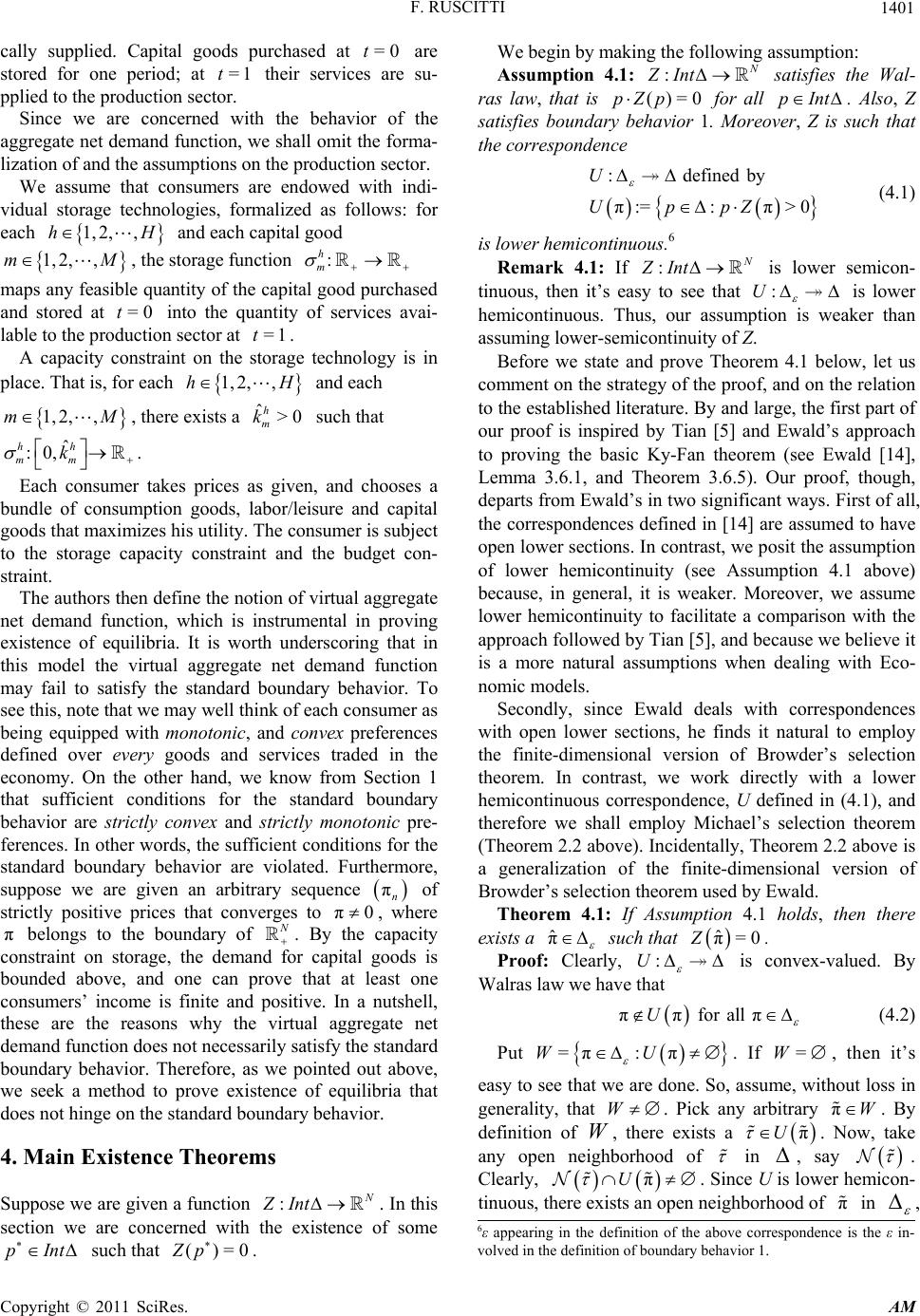 F. RUSCITTI1401 pplie the producor. feasible qu tored atvai- lable to the pr or ea Each consumes a bundle of consumtion gor/leisure and capital goods that maximes his uty. The consumect to e of equilibria. It h underscorin th cally supplied. Capital goods purchased at are stored for one period; at =1t their services are su- d to the production sector. Since we are concerned with the behavior the aggregate net demand functie shall omit the forma- lization of and the assumptions o =0t of tion sect vices a e er is subj ng that i on, w n ods, labo tili is wort We assume that consumers are endowed with indi- vidual storage technologies, formalized as follows: for each 1, 2,,hH and each capital good 1, 2,, M, the storage function : h m maps anyantity of the capital good purchased and sthe quantity of ser m =0t odu into ction sector at =1t. A capacity constraint on the storage technology is in place. That is, fch 1, 2,,hH and each m 1, 2,, M, there exists a ˆ>0 h m k such that ˆ :0, hh mm k . r takes prices as given, and choos p iz the storage capacity constraint and the budget con- straint. The authors then define the notion of virtual aggregate net demand function, which is instrumental in proving existenc is model the virtual aggregate net demand function may fail to satisfy the standard boundary behavior. To see this, note that we may well think of each consumer as being equipped with monotonic, and convex preferences defined over every goods and services traded in the economy. On the other hand, we know from Section 1 that sufficient conditions for the standard boundary behavior are strictly convex and strictly monotonic pre- ferences. In other words, the sufficient conditions for the standard boundary behavior are violated. Furthermore, suppose we are given an arbitrary sequence πn of strictly positive prices that converges to π0, where π belongs to the boundary of . By the capacity constraint on storage, the demand for capital goos is bounded above, and one can prove that ast one nsumers’ income is finite and positive. In a nutshell, these are the reasons why the virtual aggregate net demand function does not necessarily satisfy the standard boundary behavior. Therefore, as we pointed out above, we seek a method to prove existence of equilibria that does not hinge on the standard boundary behavior. 4. Main Existence Theorems d leat co Su pose we are given a funpction : ZInt ence . In t of his some such that ing assumption section we are concerned with the exist pInt ()=0. Zp We begin by making the follow: Assumption 4.1: : ZInt satisfies the Wal- hat is ()pZ ras law, t=0p for all pInt. Also, Z sa h that th tisfies boundary behavior 1. Moreover, Z is suc e correspondence :defined by π:=: π>0 U UppZ (4.1) is lower hemicontinuous.6 Remark 4.1: If : ZInt o see that U is low tinuous, then it’s easy t is lower assumption is weaker than asontinuity of Z. 4.1 bel e, the first part of ou nal version of Browder’s selection th er semicon- : hemicontinuous. Thus, our suming lower-semic Before we state and prove Theoremow, let us comment on the strategy of the proof, and on the relation to the established literature. By and larg r proof is inspired by Tian [5] and Ewald’s approach to proving the basic Ky-Fan theorem (see Ewald [14], Lemma 3.6.1, and Theorem 3.6.5). Our proof, though, departs from Ewald’s in two significant ways. First of all, the correspondences defined in [14] are assumed to have open lower sections. In contrast, we posit the assumption of lower hemicontinuity (see Assumption 4.1 above) because, in general, it is weaker. Moreover, we assume lower hemicontinuity to facilitate a comparison with the approach followed by Tian [5], and because we believe it is a more natural assumptions when dealing with Eco- nomic models. Secondly, since Ewald deals with correspondences with open lower sections, he finds it natural to employ the finite-dimensio eorem. In contrast, we work directly with a lower hemicontinuous correspondence, U defined in (4.1), and therefore we shall employ Michael’s selection theorem (Theorem 2.2 above). Incidentally, Theorem 2.2 above is a generalization of the finite-dimensional version of Browder’s selection theorem used by Ewald. Theorem 4.1: If Assumption 4.1 holds, then there exists a ˆ π such that ˆ π=0Z. Proof: Clearly, :U is convex-valued. By Walras law we have that ππUfor all π (4.2) Put =π:πWU . If, then it’s easy to see that we are done. So, assume, generality, that =W without loss in W. Pick anitrary y arbπW . By finiti Now, take de on of, there exists a W πU. any open neighborhood of in , say . Clearly, πU . Since U is lowecon- tinuous, there ets an open neighbf π in r hemi xisorhood o , 6ε appearing in the definition of the above correspondence is the ε in- volved in the definition of boundary behavior 1. Copyright © 2011 SciRes. AM 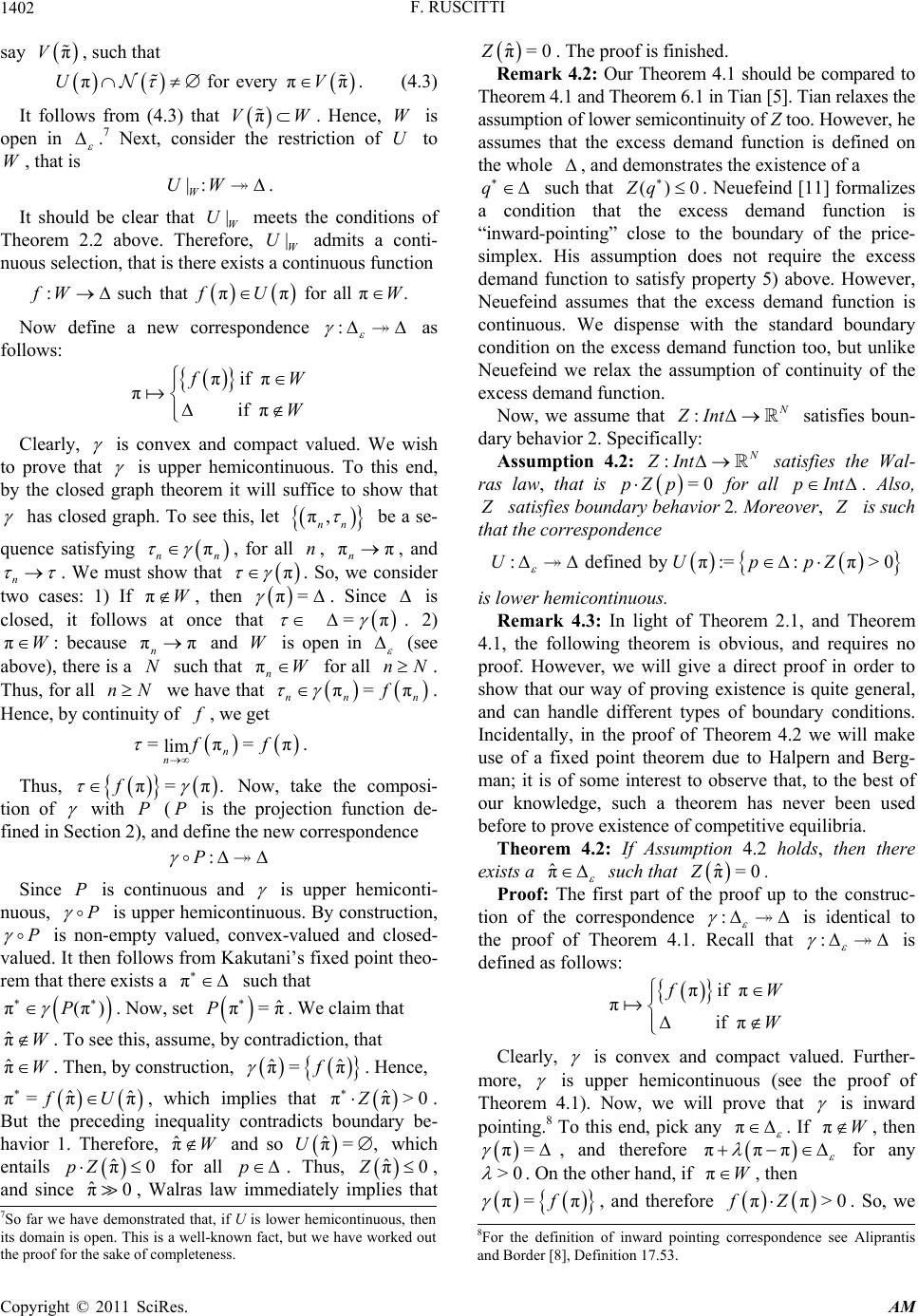 F. RUSCITTI 1402 say πV, such that r everyππUV fo π . (4.3) It followm (4.3) that πVW. Hence, W is n in s fro ope , that is nuous selection, t . 7 Nn Th above. Th, admits a conti- hat is therexists a cnuous function ext, consider the restrictioof U to W |: W UW It should be clear that |W U meets the conditions of eorem 2.2 . erefore e |W U onti :such thatππforall π. WfUW Now define a new correspondence : as follows: πif π π if π W W Clearly, is convex and compact valued. We wish to prove that is upper hemicontinu. To this end, d graph theorem it will suffice to show that ous by the close has clos graph. To see this, let ed π, nn be a se- quence satisfying π nn , for all n, ππ n, and n . We must show that π er . So = , we consi . Sin d o cases: 1) If πW, then π ce tw is closed, it followsthat at once =π . 2) because ππ n andopen in πW: W is (see above), there is a h that or all nN. Thus, for all nN we have that N sucπnW f π nn n . by continu π=f Hence,ity of , we g π= lim n n ff Thus, π= .f Now, et =π. π take the composi- tion of with P (P is the projection function de- finen 2), and define the new correspondence d in Sectio :P Since P is continuous and is upper hemiconti- nuous, P is upper hemicontinuous. By construction, P va is no th . Th =f n-empty valued, co-valued and closed- en, ion, e, nve ta x lued. Iten follows from Kakuni’s fixed point theo- rem that there exists a π such that (π)P . Now, set ˆ π=πP. We claim that ˆ πW . To see this, assume, by contradiction, that ˆ πW π by constructˆ =πf. Henc ˆ π ˆˆ ππU , which implies that π >0. ˆ π= s, ˆ ππZ e preceding inequality contradicts boundary But havi entails ˆ π th or pZ be- 1. Therefore, ˆ πW an, whichd so U 0 for all p. Thu ˆ π0 Z , and since ˆ π0, Walras law immediately implies that ˆ π=0Z. The proof ihed. Rema Theorem 4ould be coo Theorem 4.1 and Theorem 6.1 in Tian [5]. Tian relaxes the of lower semicontinuity s finis 4.2: Our.1 shmpared t of Z too. However, he rk assumption assumes that the excess demand function is defined on the whole , and demonstrates the existence of a q such that ()0Zq . Neuefeind [11] formalizes a condition that the excess demand function is “inward-poting” close to the boundary of the p . His assumoes not require the excess demand function to satisfy property 5) above. However, Neuefeind assumes that the excess demand function is continuous. We dispense with the standard boundary condition on the excess demand function too, but unlike Neuefeind we relax the assumption of continuity of the excess demand function. Now, we assume that : inrice- ption dsimplex ZInt satisfies boun- dary behavior 2. Specifically: Assumption 4.2: : ZIn satisfies the Wal- t ras law, that is =0 for pZ ppInt . Also, all satisfies boundary behavior 2. Moreover, is such e that the correspondenc π :definedby π:= :>0 UUppZ is lower hemicontinuous. Rema 4.1, the fo sh rk 4.3: In light of Theorem 2.1, and Theorem llowing theorem is obvious, and requires n ive a direct proof in order to o proof. However, we will g ow that our way of proving existence is quite general, and can handle different types of boundary conditions. Incidentally, in the proof of Theorem 4.2 we will make use of a fixed point theorem due to Halpern and Berg- man; it is of some interest to observe that, to the best of our knowledge, such a theorem has never been used before to prove existence of competitive equilibria. Theorem 4.2: If Assumption 4.2 holds, then there exists a ˆ π such that ˆ π=0 Z. Proof: The first part of the proof up to the construc- tion of the correspondence : is identical to the prooheorem 4.1tha is f of T. Recall t : defined as follows: π π if π if π W W Clearly, is convex and compact valued. Further- more, Theorem 4. is u 1). pper hemicontinuous (see the proof of Now, we will prove that is inward pointing.8 Tthis end, pick any πo . If πW , then π= , and therefore πππ for any >0 . On the other hand, if πW, then π=πf , and therefore o, we ππ>0fZ. S 7So far we have demonstrated that, if U is lower hemicontinuous, then 8For the definition of inward pointing correspondence see Aliprantis its domain is open. This is a well-known fact, but we have worked out the proof for the sake of completeness. and Borde [8], Definition 17.53. Copyright © 2011 SciRes. AM 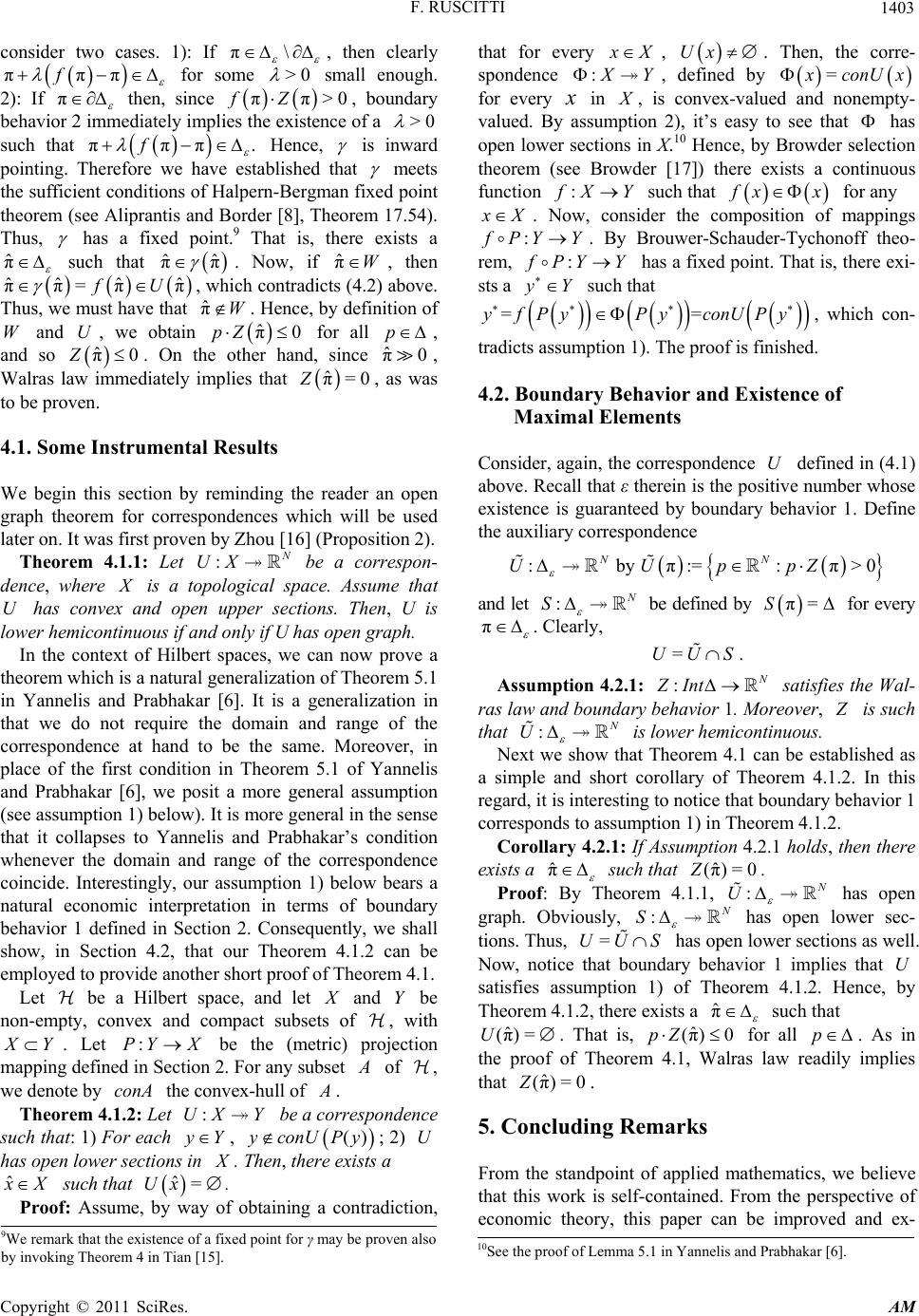 F. RUSCITTI1403 consider two cases. 1): If π\ , then clearly ππfπ for so>0me small enough. 2): If π then, since fboundary ππZ n >0, behavior 2 immediately implies the existece of a >0 such tπ. hat πf π , Hence is inward pointingfore we have established that . There meets the sufficient conditions of Halpern-Bergman fixed point theorem (see Alipra [8], Theorem 17.54). Thus, ntis and Border has a fixed point. That is, there exists a ˆ π 9 such that ˆˆ ππ . Now, if ˆ πW, then ˆˆ ˆ ˆ ππ=ππfU , which contradicts (4.2) above. Thus, we must have that ˆ πW. Hence, by definition of W and U, we obtain ˆ π0Zp for all p , ˆ πther hand, since ˆ π0, Walras law immediately implies that ˆ π=0Z, as was to be proven. 4.1. Some Instrumental Results We begin this and so 0Z. On the o section by reminding the reader an open which will be used 6] (Proposition 2). graph theorem for correspondences later on. It was first proven by Zhou [1 Theorem 4.1.1: Let : UX be a correspon- dence, where is a topological space. Assume that U has convex and open upper sections. Then, U is lower hand only if U hemicontinuous if as open graph. In the context of Hilbert spaces, we can now prove a theorem which is a natural generalization of Theorem 5.1 in Yannelis and Prabhakar [6]. It is a generalization in that we do not require the domain and range of the correspondence at hand to be the same. Moreover, in place of the first condition in Theorem 5.1 of Yannelis and Prabhakar [6], we posit a more general assumption (see assumption 1) below). It is more general in the sense that it collapses to Yannelis and Prabhakar’s condition whenever the domain and range of the correspondence coincide. Interestingly, our assumption 1) below bears a natural economic interpretation in terms of boundary behavior 1 defined in Section 2. Consequently, we shall show, in Section 4.2, that our Theorem 4.1.2 can be employed to provide another short proof of Theorem 4.1. Let be a Hilbert space, and let and Y be non-empty, convex and compact subsets of , with Y. Let :PY X be the (metric) projection mapping defined in Section 2. For any subset of , we denote by conA the convex-hull of . Theorem 4.1.2: Let :UXY be a correspondence such that: 1) For each Y, () conUP y; 2) U has open lower sections in . Then, there exists a ˆ X such that Ux Proof: Assume, by wining a contradiction, that for every ˆ=. ay of obta X , . Then, th Ux e corre- spondence : Y , ded by efin = conU ery x in for ev, is co va nvevaluex-d and nonempty- lued. By assumption 2), it’s easy to see that has open lower sectioX.10 Browder selection theorem (se [17]) there exists function ns in rowder Hence, by e B : a continuous XY such that xx for any X . Now, consider the composition of maings : pp PY Y. By Brouwer-Schauder-Tychonoff theo- rem, : PY Y has a fixed point. That is, there exi- sts a Y such that =PyPyconUPy , which con- tradic1). The proof is finished. 4.2. Bound =y f ts assumption ary Behavior and Existence of Maximal Elements onsider, again, the correspondence defined in (4.1) whose exisundary behavior 1. Define e auxiliary correspondence CU above. Recall that ε therein is the positive number tence is guaranteed by bo th :byπ:=: π>0 NN UUppZ and let : S be defined by π=S for every π . Clearly, =UUS . Assum : : ption 4.2.1ZInts the Wal- ras law and bounbehavior 1. Mo re satisfie dary over, is such : that U Next we show is tinuous. that Tbe established as a rollary of Theo sponds to ass lower hemicon heorem 4.can 1 simple and short corem 4.1.2. In this regard, it is interesting to notice that boundary behavior 1 correumption 1) in Theorem 4.1.2. Corollary 4.2.1: If Assumption 4.2.1 holds, then there exists a ˆ π such that ˆ (π)=0Z. Proof: By Theorem 4.1.1, : U has open graph. Obviously, : S has open lower sec- tions. Thus, =UUS has open lower sections as well. Now, noat boundaryr 1 imptice th be exists a ˆ π havio orem 4.1.2. lies that sa U tisfies assumption 1) of TheHence, by Theorem 4.1.2, there such that ˆ (π)=U . Tˆ (π)0Z hat is, p for all p. As in the proof of Theorem 4.1, Walras law readily impl that ˆ (π)=0Z. From dp ies 5. Concluding Remarks the stanoint of applied mathematics, we believe at this work is self-contained. From the perspective of be improved and ex- th economic theory, this paper can 9We remark that the existence of a fixed point for γ may be proven also by invoking Theorem 4 in Tian [15]. 10See the proof of Lemma 5.1 in Yannelis and Prabhakar [6]. Copyright © 2011 SciRes. AM 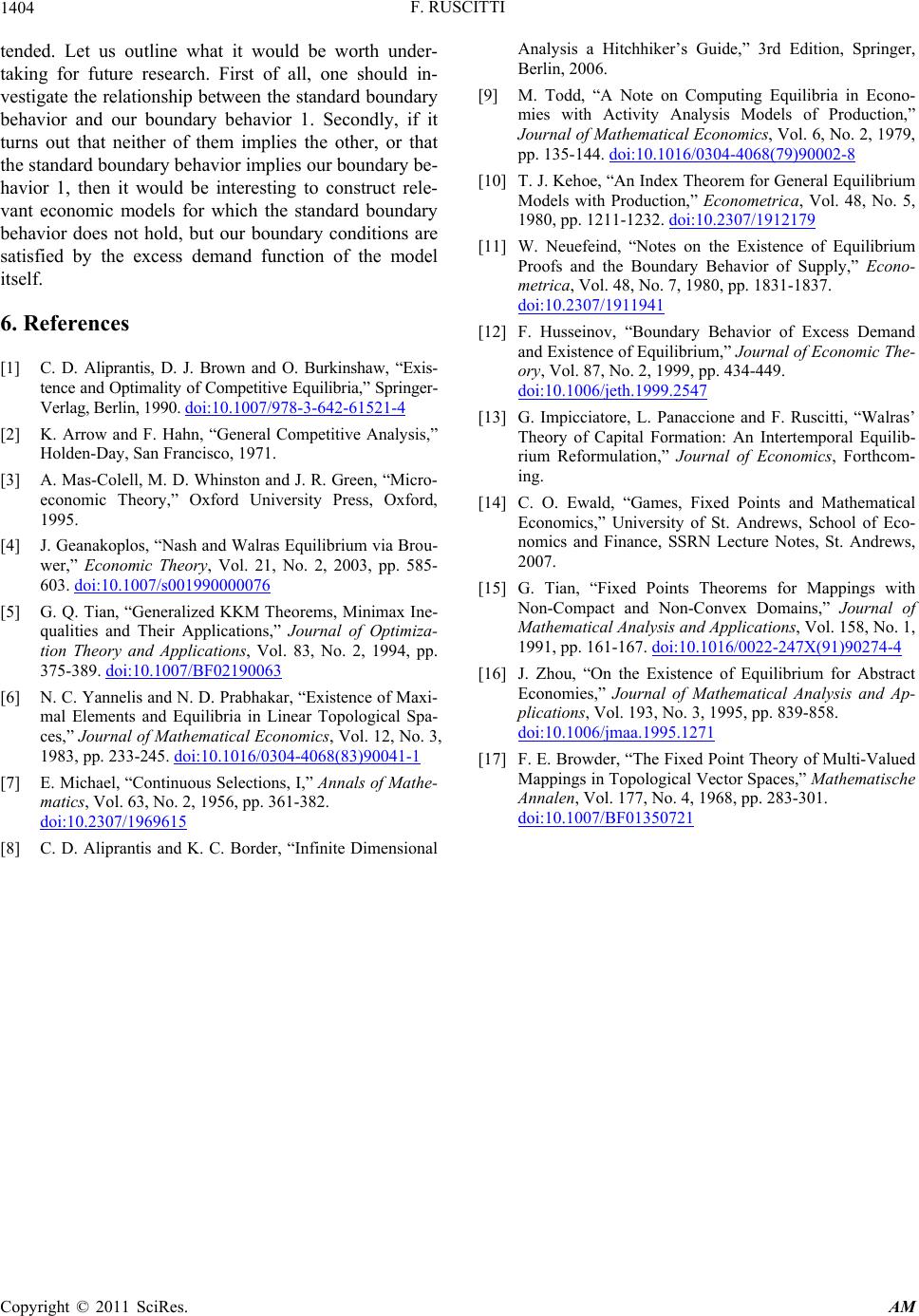 F. RUSCITTI Copyright © 2011 SciRes. AM 1404 nded. Let us outline what it would be worth under- D. Aliprantis, D. J. Brown and O. Burkinshaw, “Exis- tence and Optimality of Competitive Equilibria,” Spri 990. doi:10.1007/978-3-642-61521-4 te taking for future research. First of all, one should in- vestigate the relationship between the standard boundary behavior and our boundary behavior 1. Secondly, if it turns out that neither of them implies the other, or that the standard boundary behavior implies our boundary be- havior 1, then it would be interesting to construct rele- vant economic models for which the standard boundary behavior does not hold, but our boundary conditions are satisfied by the excess demand function of the model itself. 6. References [1] C. nger- Verlag, Berlin, 1 ] K. Arrow and F. Hahn, “General Competitive Analysis,” rd, Equilibrium via Brou- [2 Holden-Day, San Francisco, 1971. [3] A. Mas-Colell, M. D. Whinston and J. R. Green, “Micro- economic Theory,” Oxford University Press, Oxfo 1995. [4] J. Geanakoplos, “Nash and Walras wer,” Economic Theory, Vol. 21, No. 2, 2003, pp. 585- 603. doi:10.1007/s001990000076 [5] G. Q. Tian, “Generalized KKM Theorems, Minimax Ine- qualities and Their Applications,” Journal of Optimiza- tion Theory and Applications, Vol. 83, No. 2, 1994, pp. 375-389. doi:10.1007/BF02190063 [6] N. C. Yannelis and N. D. Prabhakar, “Existence of Maxi- mal Elements and Equilibria in Linear Topological Spa- ces,” Journal of Mathematical Economics, Vol. 12, No. 3, 1983, pp. 233-245. doi:10.1016/0304-4068(83)90041-1 [7] E. Michael, “Continuous Selections, I,” Annals of Mathe- matics, Vol. 63, No. 2, 1956, pp. 361-382. doi:10.2307/1969615 [8] C. D. Aliprantis and K. C. Border, “Infinite Dimensional ’s Guide,” 3rd Edition, Springer, ctivity Analysis Models of Production,” Analysis a Hitchhiker Berlin, 2006. [9] M. Todd, “A Note on Computing Equilibria in Econo- mies with A Journal of Mathematical Economics, Vol. 6, No. 2, 1979, pp. 135-144. doi:10.1016/0304-4068(79)90002-8 [10] T. J. Kehoe, “An Index Theorem for General Equilibrium Models with Production,” Econometrica, Vol. 48, No. 5, 1980, pp. 1211-1232. doi:10.2307/1912179 [11] W. Neuefeind, “Notes on the Existence of Equilibrium Proofs and the Boundary Behavior of Supply,” Econo- metrica, Vol. 48, No. 7, 1980, pp. 1831-1837. doi:10.2307/1911941 [12] F. Husseinov, “Boundary Behavior of Excess and Existence of Equil Demand ibrium,” Journal of Economic The- ory, Vol. 87, No. 2, 1999, pp. 434-449. doi:10.1006/jeth.1999.2547 [13] G. Impicciatore, L. Panaccione and F. R Theory of Capital Formation uscitti, “Walras’ : An Intertemporal Equilib- omics,” University of St. Andrews, School of Eco- ompact and Non-Convex Domains,” Journal of rium Reformulation,” Journal of Economics, Forthcom- ing. [14] C. O. Ewald, “Games, Fixed Points and Mathematical Econ nomics and Finance, SSRN Lecture Notes, St. Andrews, 2007. [15] G. Tian, “Fixed Points Theorems for Mappings with Non-C Mathematical Analysis and Applications, Vol. 158, No. 1, 1991, pp. 161-167. doi:10.1016/0022-247X(91)90274-4 [16] J. Zhou, “On the Existence of Equilibrium for Abstract Economies,” Journal of Mathematical Analysis and Ap- plications, Vol. 193, No. 3, 1995, pp. 839-858. doi:10.1006/jmaa.1995.1271 [17] F. E. Browder, “The Fixed Point Theory of Mult Mappings in Topological Vec i-Valued tor Spaces,” Mathematische Annalen, Vol. 177, No. 4, 1968, pp. 283-301. doi:10.1007/BF01350721
|